#BreadMaking
Explore tagged Tumblr posts
Text
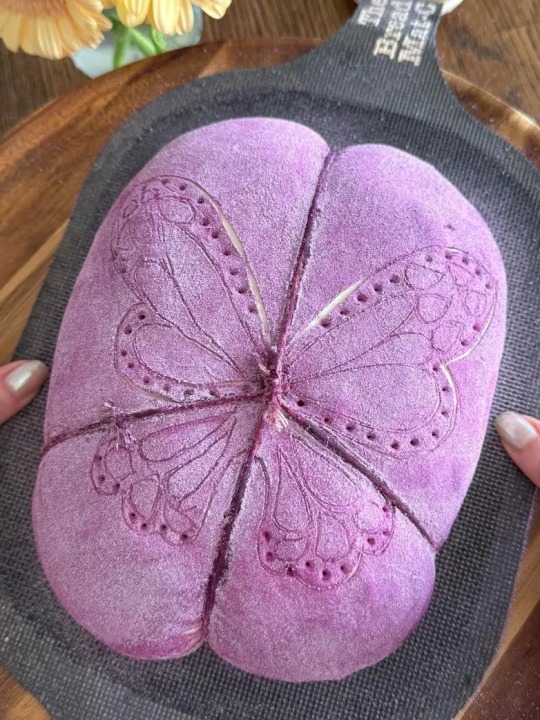

#cottagecore#cottage aesthetic#cottage#cottagestyle#sourdough#sourdougbread#breadmaking#breadcore#bread#purple#pink#homemade bread#food
4K notes
·
View notes
Text
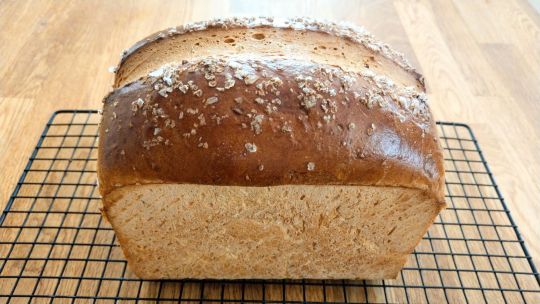
Every now and then, as a change from my standard white loaf, @dduane will bake something a bit different.
It might be an Irish Batch Loaf (the standard loaf is there too) or a Lahy's No-Knead.
The one in the header shot is a Light Rye, dressed up with an egg wash, a sprinkle of Maldon salt and a lame-slash.
It's really good... :->

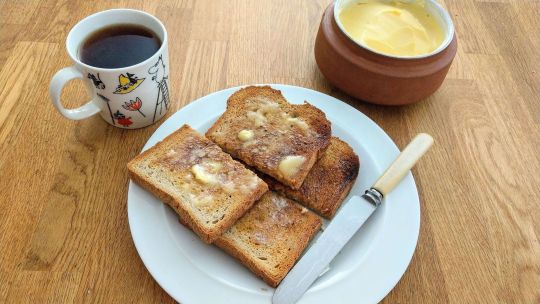
284 notes
·
View notes
Text
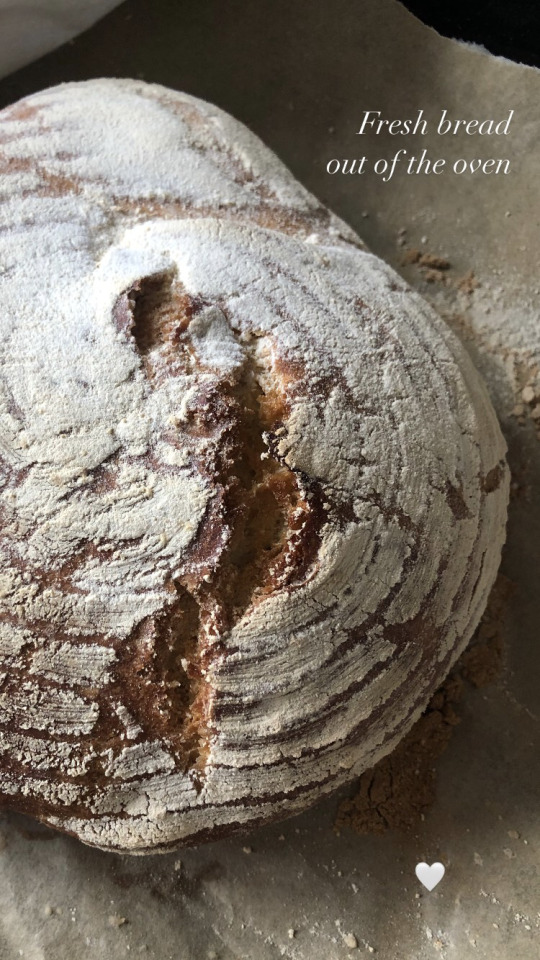
my kitchen smells like a bakery
#my photography#my content#yourdependente#freshly baked#breadmaking#breadlover#bread#homemade bread#home baking#homecooking#homemade#made with love#that girl#wifey material#baked goods#yummy yummy
375 notes
·
View notes
Text
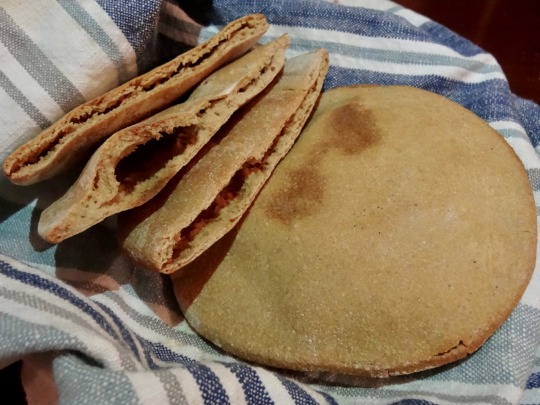
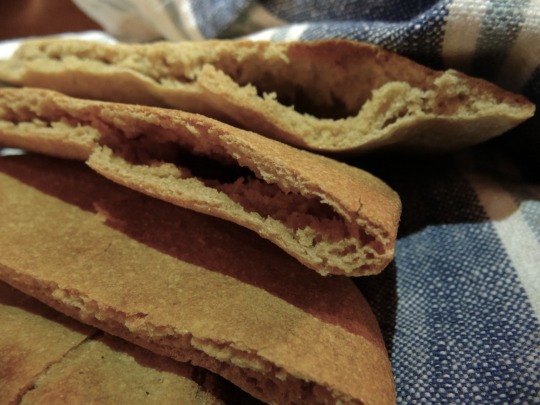
[ID: One puffy circle of bread, and three which have been halved to show an internal pocket, on a striped blue and white kitchen towel. End ID]
خبز الكماج / Khubiz al-kmaj (Palestinian flatbread)
Khubiz al-kmaj is a thin flatbread with an internal pocket. It is commonly eaten with breakfast to scoop up dips such as hummus, used to eat stews, served alongside main dishes, and used to make sandwiches and to wrap falafel. "خُبْز," pronounced "khubz" or (in Levantine varieties of Arabic) "khubiz," comes from the root خ ب ز (kh-b-z), which also produces the word "خَبَزَ" "khabaza" (Levantine: "خَبَز" "khabaz"), "to bake."
This bread is eaten across the Levant and in Greece, with slight differences in terminology and style. It is variously called "خُبْز العَرَبِيّ" (khubz al-'arabiyy; Arabian bread), "خُبْز "البَلَدِيّ (khubz al-baladiyy; bread from my country), or (occasionally) "خُبْز البيتة" or "البيتا" (khubz al-bita), a borrowing from "pita." ("Pita" itself is perhaps from Greek "πίτα" "pita," or the modern Hebrew "פיתה.") The bread is referred to as "khubiz al-kmaj" in Palestine, from the Turkic "kömeç" / كُمَجْ ("bread baked in ashes"). The collective term for the bread in general is كماج (kmāj); each individual piece of bread is referred to with the singulative "كماجة" (kmāja).
Today, kmaj is frequently made with white flour; some people add olive oil or milk powder to ensure a very soft dough. Leila el-Haddad writes that a more traditional method omits milk and uses whole white spring wheat, a whiteish wheat grain harvested in late spring and ground without removing the bran.
Since the late 20th century, many Palestinian households have used an electric cooker (طنجرة الكهرباء; ṭanjara al-kahrabā') to cook kmaj, placing one kmaja inside of the chamber and one on top and allowing both to bake at the same time. These aluminum and tin cookers, which were invented in Gaza and became popular there during the first intifada in the late 1980s, are designed to route electricity through a metal pipe or spiral wire on the underside of their lids, heating both the top and the inside of the cooker simultaneously.
The cookers' popularity can be attributed in part to a curfew that Israel imposed on Gazan refugee camps during the intifada, supposedly in an attempt to restrict the movements of resistance fighters. Refugees in the Jabalia camp in the north, for example, unable to afford home stoves, and without the necessary outdoor space to make familial clay ovens, would have to wait in line for hours every day to get bread from shared ovens, risking curfew violations; household electric cookers were far more convenient. The success of local industry and innovation in the form of Gazan-manufactured technology was also symbolically and strategically important during the first intifada, in which Palestinians employed strikes and boycotts (largely organized by women) of Israeli companies and goods as a strategy of resistance to occupation.
An electric cooker is still today considered a very important tool, as it spares families the need to purchase kmaj (the price of which was soaring compared to the cost of flour in the 2010s, and which was often of inferior quality compared to what could be made at home). They are frequently given as wedding or housewarming presents. Lack of access to electricity, though, imposes a limiting condition on the usage of these cookers, as Israel has for over a decade strangled the flow of power to Gaza: Abier Almasri wrote in 2017 that tasks such as cooking and laundry had to be rushed during the four or so hours a day when electricity was available. In this environment, electric cookers are useful in that they can prepare a lot of bread in a short period of time. Fathia Radwan said in 2022 that she would wake up early, after the nightly power outage, to prepare more than 100 loaves of bread at a time for her family of nine.
Today, the taxes that Israel levies on imports of raw materials into Gaza makes the cost of new electric cookers, which sometimes exceeds 120 shekels (37 USD), too expensive for some families to afford. The difficulty and expense of importing materials, and the impossibility of exporting goods to foreign markets with the advent of the 2007 siege, also limit the number of factories in Gaza that are able to manufacture these cooking pots. The aluminum industry, introduced to Gaza in the 1960s and once the basis of a manufacturing and economic renaissance in the region, deteriorated as a result of the siege, as factories were no longer able to export goods to the West Bank and were newly reliant on imports of raw materials from Egypt. Even parts to repair electric cookers are expensive, due to a tax levied on items judged by Israel to have a "dual," i.e. a possible civilian and military, use.
Still, repairman Iyad Faraj estimates that over half the homes in Gaza have and use an electric cooker, as maintaining, repairing, and operating one is cheaper than having a gas pipe installed (at 68 shekels, 20 USD) and purchasing gas. Electric pots thus stand in many homes as both a utilitarian item, and a symbol of Palestinian ingenuity and resistance to Israel's attempts at impoverishment and starvation.
Support Palestinian resistance by contributing to Palestine Action’s bail fund or to Palestine Legal’s defence fund, by attending court or making a sign to support the Elbit Eight, or by buying an e-sim for distribution in Gaza.
Ingredients:
500g (4 cups + 3 Tbsp) white whole wheat (spring) flour
1/2 Tbsp (5g) active dry yeast
1/2 Tbsp (6.25g) vegetarian granulated sugar
1/2 Tbsp (7.25g) kosher salt
About 2 1/4 cups (530mL) room-temperature water, divided
Olive oil
White whole wheat flour is flour that has a white color once ground, despite the fact that it includes both the bran and the germ of the wheatberry. It is milled from white spring wheat (so named because it is harvested in late spring).
You may instead mix white all-purpose flour and brown whole wheat flour in your desired proportion. Keep in mind that whole wheat flour will need more water and more kneading than white flour. If you’re using all white flour, you will need about 1 1/4 cup (300mL) water.
Instructions:
1. Mix flour, yeast, sugar, and salt in a large mixing bowl. Add water gradually until dry ingredients come together into a sticky dough.
2. Knead the dough on the countertop or in a wide, shallow bowl until smooth, about 5 minutes. (If using whole wheat or white whole wheat flour) continue incorporating water into the dough as you knead to maintain a tacky texture.
3. Fold the dough into a ball and return to the bowl, seam-side down. Pat the top of the dough with some olive oil, cover the bowl, and let rise for an hour.
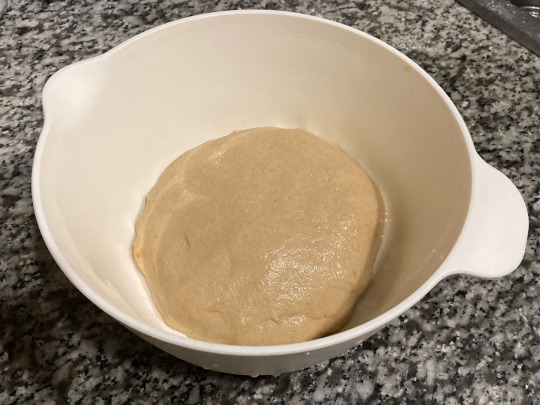

4. Pinch the dough into about 8 balls of equal size (about 110g each). Cover and let rest for 10 minutes.
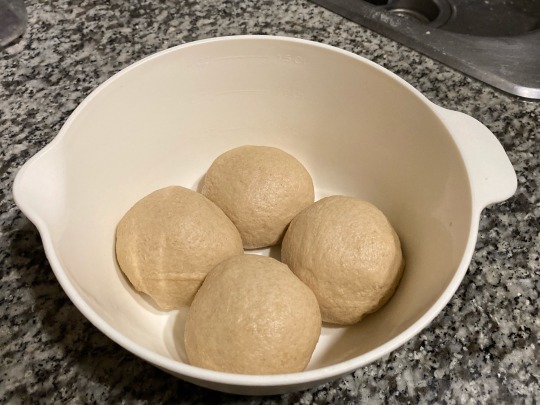
5. On a lightly floured surface, roll out each ball of dough into a circle about 1/4" (1/2cm) in thickness. Set dough circles on a surface prepared with parchment paper and cover closely with a kitchen towel or plastic wrap. Let rest and ferment for at least 1 and up to 10 hours.
An overnight rest is traditional in Palestine and will create a more complex flavor in the bread (see note below).
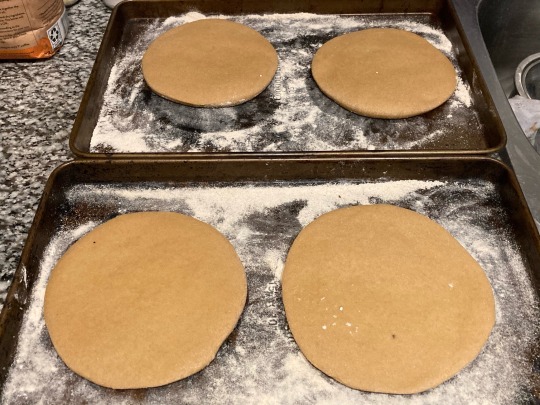
6. Remove each circle of dough from its resting place with a metal spatula and roll it out to a 1/4” thickness again. Preheat a baking stone or sheet in the top third of an oven at 500 °F (260 °C), and then cook breads in the oven for three minutes, until large bubbles have begun to form.

7. Flip bread over and cook for another 3 minutes on the other side, until golden brown and puffed up completely.
8. Wrap breads in a kitchen towel or tea towel and allow to steam for a few minutes while the others cook.
Notes
The climate where I live is dry enough that I have discovered a risk of my breads becoming crackers if I leave them out overnight. The dried-out flatbread does puff up in the oven, but the resulting product is not as nice and fluffy as it should be.
Through experimentation, I have found the best method of both preventing drying out and guaranteeing that the flatbreads will puff up during cooking the next day is:
1. Roll out the dough and place dough circles on a lightly oiled surface. Cover them closely with lightly oiled plastic wrap.
2. The next day, fold dough circles back into balls. Place seam-side down and roll out again on a lightly floured surface.
3. Bake as described above.
If you live in a humid environment, the first instructions given in the recipe above should work for you.
426 notes
·
View notes
Text

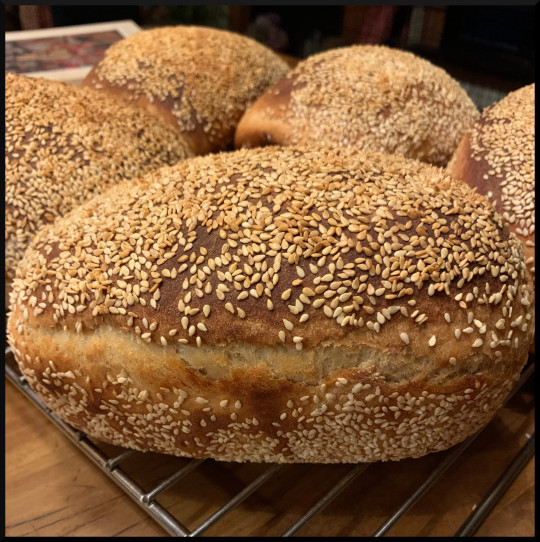
Organic Flour Fresh Yeast Risen Loaves Honey, Sea Salt & Toasted Sesame Seed Flavors
72 notes
·
View notes
Text

the french are NOT asleep but post fucked up runic and biblically accurate baguette anyway
#breadmaking#yea the crust didnt turn out on the biblically accurate one i know. still tasted damn good tho
14 notes
·
View notes
Text
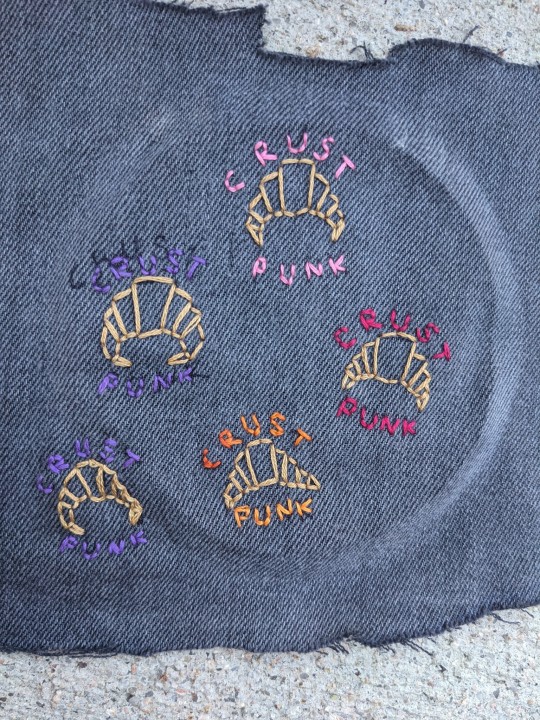
Yeah I sew! Yeah I'm a crust punk! What about it????
#embroidery#sewing#hand embroidery#diy#solarpunk#crust punk#punk#punk patches#cute pun#puns#crustie#croissant#bread#bread puns#breadmaking#baking#bucky sews#bucky crafts
202 notes
·
View notes
Text
24 notes
·
View notes
Text
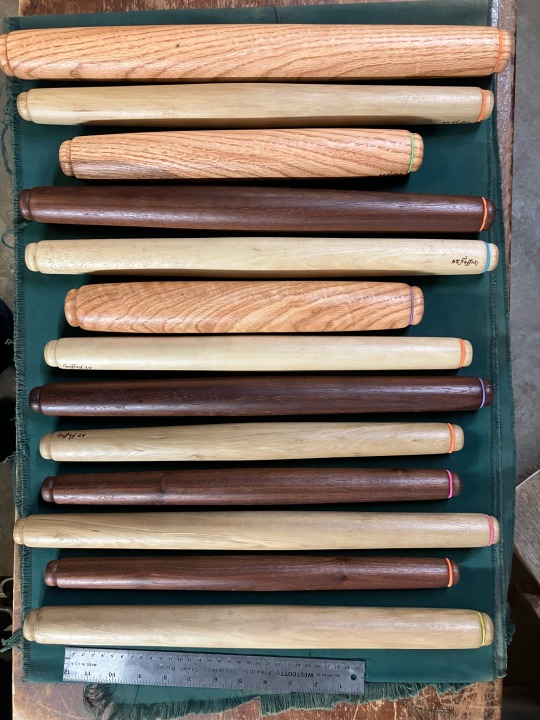
Some more French Rolling Pins added to inventory! It’s a nice break from carving spoons to do a little lathe work!!!
#wood carving#wood working#wood spoon#spoons#cooking#my art#art spoon#cast iron#kitchen#baking#breadmaking
22 notes
·
View notes
Text

here is a filipino bakery breads pt. 1!
mamon : soft fluffy bread, very light and airy sponge cake.
egg pie : filipino pie with egg custard filling.
puto : a steamed rice cake made from slightly fermented rice.
spanish bread : bread roll shape with a traditional sweet filling made of butter or margarine and brown sugar and sprinkled with bread crumbs on the outside.
yema cake : chiffon cake with custard filling
ensaymada : filipino style brioche, tender, fluffy, light and sweet. popular in the Philippine bakeries.
ube cheese bread : combination of intense purple yam and cheese. a soft fluffy bread with cheese filling and a purple yam bread.
cheese bread : creamy, sweet and savoury cheese soft bread.
star bread : (popular as "putok") because of the design in the top. it looked like it popped. also topped with white sugar.
kalihim : (popular as "pan de regla") pink bread pudding filling made from stale bread with a mix of sugar, butter, eggs, milk and vanilla.
kabayan : soft muffin with a distinct shape of "salakot". can be toasted at the edges too.
pan de coco : fluffy bread roll filled with sweetened coconut.
#artists on tumblr#digital artist#artist#artistsupport#art#digital art#drawing#illustration#my art#artistsoninstagram#foodie#food art#food illustration#filipino#pastries#breadmaking#breads
159 notes
·
View notes
Text
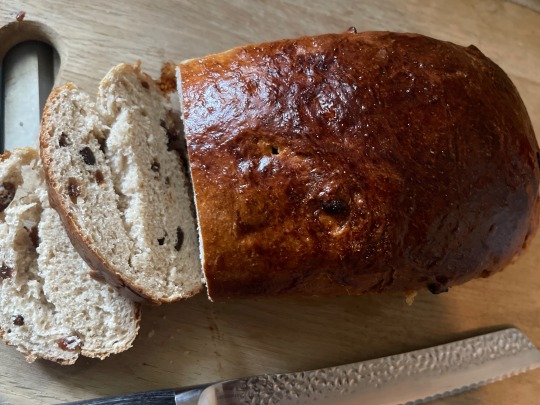
Baked some raisin bread my recipes 🥖✨
#cottagecore#cottagecoreaesthetic#aesthetic#aesthetic#baking fun#baking video#bakingfromscratch#cottagecore baking#baking#fairycore#breadmaking#quick bread
108 notes
·
View notes
Text
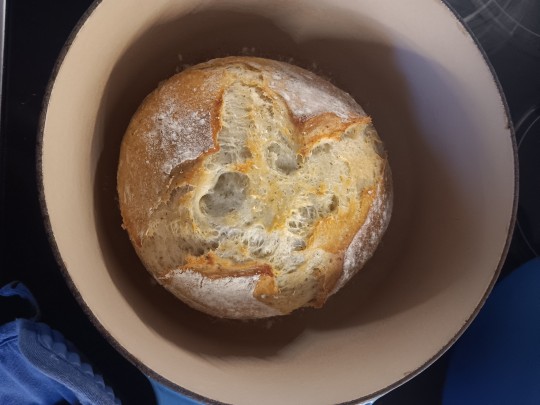
Dutch oven bread!!!
8 notes
·
View notes
Text
Today I made bread (again)
Not just because we'd eaten the last lot, although that was a reason.
It was an experiment which I've intended for a long while but keep forgetting to do: make one loaf using the Kenwood stand mixer (knead time 12 minutes) and the other in the Magimix / Cuisinart food processor (knead time 2 minutes) and see which came out best.
It's the same recipe each time...
500g bread flour
7g dried yeast
7g table (fine-grain) salt
250ml warm water
30ml olive oil
...with everything else - first & second rising, then baking - done as simultaneously as I could manage.
*****
The result was a surprise; I'd expected longer kneading would cause better-developed gluten and that loaf would rise more, but it actually ended up as the smaller of the two.
The 2-minute Magimix loaf is on the left, the 12-minute Kenwood one is on the right.


Despite the visible difference in size, their weight after baking (681g and 682g) is so close as to be identical.
Once they cooled, I sliced them to see what the insides were like.
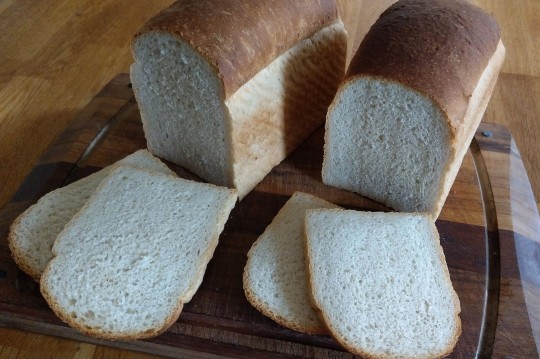
And here's their crumb. First the Kenwood...
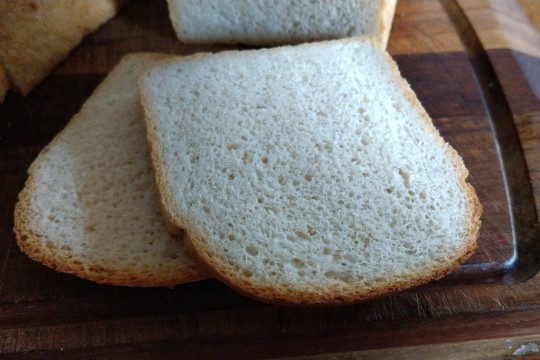
...then the Magimix.
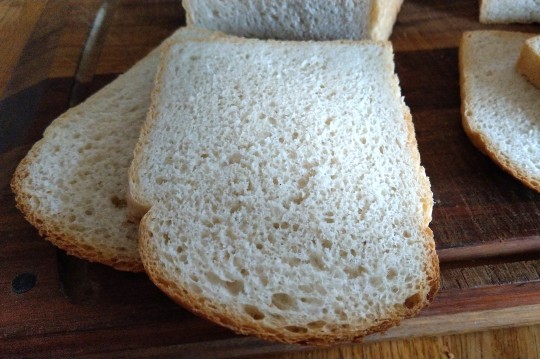
There's hardly any visible difference apart from slightly larger holes at the top of the Magimix loaf.
There's a slight tactile difference; the Kenwood loaf crumb is firmer, not by much but enough to notice with fingertip and presumably teeth.
This might give better structural integrity to an over-filled sandwich made soggy by an overflow of sauces, relishes and other tracklements, or for toast softened by an excessive quantity of butter (although my Dad would have said there was no such thing).
Whatever.
I've completed my experiment, and proved that an extra 10 minutes or so of kneading doesn't do anything dramatic, at least with the brands of flour and yeast we've used successfully for some years.

OK, cleaning the Kenwood bowl and dough hook took less time and trouble than cleaning the Magimix bowl, dough blade, lid and feed chute, but again it was no more than a couple of minutes which were more than cancelled out by the kneading times.
*****
And now, since I seem to have a couple of slices of splendidly fresh bread needing attention, several kinds of cheese and cold cuts in the fridge, and various sauces, relishes and tracklements in the cupboard, I'm going to make myself one of those over-filled sandwiches.
I might even add an excessive quantity of butter (No Such Thing!) to the outside, then toast it... :->
361 notes
·
View notes
Text

🍏Cinnamon Apple Twist Bread 🥖
#foodlover#foodporn#comfort food#food#food menu#foodpics#food photos#foodie#foodgasm#breadlovers#breadmaking#apple pie#fallmovienight#fall food#fall aesthetic#fall baking#fall vibes#yummyfood#cozy fall#cozy food#homefood
9 notes
·
View notes
Text

⊱ɱε∂เεѵαℓ-ƭɦყɱεร⊰
#medieval#medieval cooking#medieval kitchen#primitive#primitive cooking#rustic#bread#breadmaking#breadcore#sourdough#baker#bakery#bread oven#rye bread
15 notes
·
View notes
Text
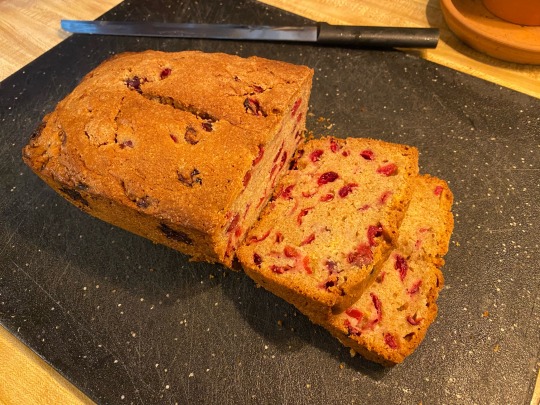
Made my grandmother’s cranberry orange bread for my family for Christmas.
4 notes
·
View notes